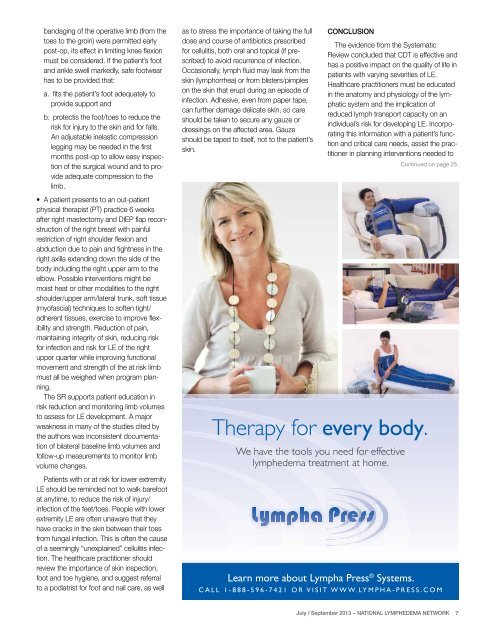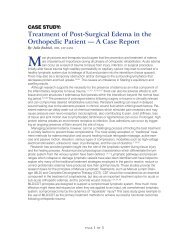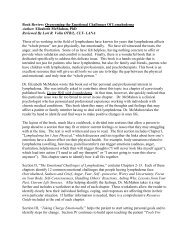Practical Application of the Systematic Review of theEvidence for <strong>Complete</strong> <strong>Decongestive</strong> <strong><strong>The</strong>rapy</strong>for Treatment of <strong>Lymphedema</strong>By: Bonnie B. Lasinski, MA, PT, CI-CS, CLT-LANA<strong>Lymphedema</strong> <strong><strong>The</strong>rapy</strong> and the Boris-Lasinski School, Woodbury, NY<strong>The</strong> Systematic Review (SR) of the Evidence…concludesthat “<strong>Complete</strong> decongestivetherapy (CDT) is effective in reducinglymphedema, although the contributionof each individual CDT component has notbeen determined…CDT improves overallquality of life and is effective for variousdegrees of LE…Manual lymph drainage(MLD) enhances the effects of compressionand has been shown to improve quality oflife (QOL) and symptoms.” (SR – Pg 599)What does this mean for clinicians inacute care, long-term, outpatient and homecare settings? How can this evidence bepractically applied to insure that individualsliving at risk or with lymphedema (LE) aresupported throughout the continuum ofcare? Physical and occupational therapists,nurses and other practitioners provide carefor patients living with or at risk for LE in avariety of healthcare settings. <strong>The</strong>re aresome who are well informed about thepathophysiology and management of LEand related lymphatic system disorderssuch as lipo-lipedema, phlebolymphedema(LE secondary to chronic venous insufficiencyor post thrombotic syndrome), however,many are not. Understanding andapplying the evidence from the SR supportsthe patient living with LE (and related disorders)to continue self-care when undergoingmedical treatment, empowering theindividual to be proactive in their healthmaintenance. Identifying potential problemsand making appropriate referral to a LEspecialist may avoid triggering a latent LE orprogression of pre-existing LE.Following an initial course of CDT, mostindividuals maintain the reduction in LE bywearing a compression garment during theday and compression bandages (or aninelastic garment) at night. <strong>The</strong> evidence foradherence with nighttime compressionbandaging and daytime compression garmentwear correlated with the maintenanceof LE reductions achieved through CDT.Knowledge of a patient’s individual LE managementprogram, including the type ofcompression garments worn, duration ofwear, and exercises/self-MLD regimen iscritical information the practitioner mustconsider when formulating tthe patient’splan of care. Incorporating the principles ofCDT into some of the self-care activitieshelps to streamline a patient’s home program,reducing the time/psychologicalburden for the individual. Consultation/referral to a LE specialist may be indicatedand modifications to a patient’s compressiongarments or exercise program may beneeded as the patient progresses throughthe episode of care.APPLICATION OF EVIDENCE TO THECLINICAL SETTING<strong>The</strong> following examples illustrate applicationof the evidence from the SR to commonmedical issues that may present to patientsat risk or living with lymphedema.• An individual with LE of the upperextremity is diagnosed with impingementsyndrome of the affected shoulder. <strong>The</strong>pain and limitation in range of motion andfunction of the affected shoulder issevere. Cortisone shot into the shoulderhas been recommended. <strong>The</strong> patientwas advised by the orthopedist to discontinuewearing the compression garmentfor a few days after the shot. <strong>The</strong>patient is unsure if this is correct andneeds to know what to do. Based on theevidence from the SR, it is clear thatwearing the prescribed compressiongarments on the affected limb/s is necessaryto prevent worsening of the LE. <strong>The</strong>patient’s compression sleeve ends at theaxilla and should not interfere with theinjection. It can be removed for theadministration of the injection but shouldbe put back on after the injection toavoid an increase in swelling.• A patient with lower extremity LE musthave an excision of a basal cell skin canceron the lymphedematous lower leg.the patient has been advised to removethe compression stocking until the surgicalwound is healed. <strong>The</strong> patient is concernedthat the leg will swell in the weeksthat the area may take to heal. However,the pressure and shear of pulling on acompression stocking may disturb thewound bed and surrounding tissues. Adiscussion with the surgeon regardingwhether the patient could be permittedto apply compression bandages over thesurgical site to facilitate wound healing isappropriate. Depending on the patient,the extent of the wound and other comorbidconditions, it may or may not beappropriate. Obtaining clearance fromthe surgeon for the patient to continue/modify the home exercise/self-MLD programis important to properly instruct thepatient with any modifications needed toenable continuation of the home programwithout compromising wound healing onthe affected limb.• A patient with lower extremity LE secondaryto obesity and chronic venousinsufficiency needs a total knee replacement.<strong>The</strong>y are only able to wear kneelength compression stockings becauseof their obesity and immobility. <strong>The</strong> incisionfrom the surgery will extend from thedistal thigh over the knee to the proximallower leg. <strong>The</strong> elastic band from the kneehigh stocking would be located over theincision line so the patient will not be ableto wear the compression stocking on theoperative side in the first weeks post-op.What can be done to minimize the swellingthat may occur in that time? Risk forinfection, skin integrity, ability to mobilizethe knee post-op, safety in transfers andambulation will affect recommendationsfor compression post-op. If compression6 NATIONAL LYMPHEDEMA NETWORK ~ July / September 2013
andaging of the operative limb (from thetoes to the groin) were permitted earlypost-op, its effect in limiting knee flexionmust be considered. If the patient’s footand ankle swell markedly, safe footwearhas to be provided that:a. fits the patient’s foot adequately toprovide support andb. protectis the foot/toes to reduce therisk for injury to the skin and for falls.An adjustable inelastic compressionlegging may be needed in the firstmonths post-op to allow easy inspectionof the surgical wound and to provideadequate compression to thelimb.• A patient presents to an out-patientphysical therapist (PT) practice 6 weeksafter right mastectomy and DIEP flap reconstructionof the right breast with painfulrestriction of right shoulder flexion andabduction due to pain and tightness in theright axilla extending down the side of thebody including the right upper arm to theelbow. Possible interventions might bemoist heat or other modalities to the rightshoulder/upper arm/lateral trunk, soft tissue(myofascial) techniques to soften tight/adherent tissues, exercise to improve flexibilityand strength. Reduction of pain,maintaining integrity of skin, reducing riskfor infection and risk for LE of the rightupper quarter while improving functionalmovement and strength of the at risk limbmust all be weighed when program planning.<strong>The</strong> SR supports patient education inrisk reduction and monitoring limb volumesto assess for LE development. A majorweakness in many of the studies cited bythe authors was inconsistent documentationof bilateral baseline limb volumes andfollow-up measurements to monitor limbvolume changes.Patients with or at risk for lower extremityLE should be reminded not to walk barefootat anytime, to reduce the risk of injury/infection of the feet/toes. People with lowerextremity LE are often unaware that theyhave cracks in the skin between their toesfrom fungal infection. This is often the causeof a seemingly “unexplained” cellulitis infection.<strong>The</strong> healthcare practitioner shouldreview the importance of skin inspection,foot and toe hygiene, and suggest referralto a podiatrist for foot and nail care, as wellas to stress the importance of taking the fulldose and course of antibiotics prescribedfor cellulitis, both oral and topical (if prescribed)to avoid recurrence of infection.Occasionally, lymph fluid may leak from theskin (lymphorrhea) or from blisters/pimpleson the skin that erupt during an episode ofinfection. Adhesive, even from paper tape,can further damage delicate skin, so careshould be taken to secure any gauze ordressings on the affected area. Gauzeshould be taped to itself, not to the patient’sskin.CONCLUSION<strong>The</strong> evidence from the SystematicReview concluded that CDT is effective andhas a positive impact on the quality of life inpatients with varying severities of LE.Healthcare practitioners must be educatedin the anatomy and physiology of the lymphaticsystem and the implication ofreduced lymph transport capacity on anindividual’s risk for developing LE. Incorporatingthis information with a patient’s functionand critical care needs, assist the practitionerin planning interventions needed to<strong><strong>The</strong>rapy</strong> for every body.We have the tools you need for effectivelymphedema treatment at home.Continued on page 25Learn more about Lympha Press ® Systems.CALL 1-888-596-7421 OR VISIT WWW.LYMPHA-PRESS.COMJuly / September 2013 ~ NATIONAL LYMPHEDEMA NETWORK 7





